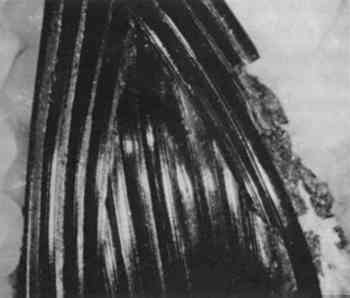BALEEN IN MUSEUM COLLECTIONS: ITS SOURCES, USES, AND IDENTIFICATIONJULIE A. LAUFFENBURGER
4 BALEEN IN THE COLLECTION OF THE WALTERS ART GALLERY4.1 JAPANESE ARMORThe Walters Art Gallery has a sizeable collection of Japanese swords, mainly collected in the late 19th century. Traditionally, a limited variety of materials have been used to wrap the hilts, including braided silk thread, paper, leather, metal wire, baleen, and even horsehair. At least 22 of the approximately 152 Japanese swords in the collection are likely wrapped in baleen. The wrapping improves the grip on the sword; bound hilts were frequently used in battle, while bare lacquer hilts were more commonly used for ceremonial purposes. The wrapping also played a decorative role in the finished product, and a variety of different wrapping techniques were used. The use of baleen, or “whalebone,” as it was often referred to in older texts, is specifically described in a book on Japanese swords by B. W. Robinson (1961). Robinson outlines a method of wrapping from the center out with lozenge-shaped spaces finished off in a neat flat-knot. This type of wrapping is the most common found on the swords in the Walters collection (fig. 1). The strips of baleen are often wrapped around a layer of same, or ray skin, that has been covered by layers of Japanese paper (Joly and Hogitaro 1979). In order to wrap the baleen strips evenly around the hardened calcified bumps of the ray skin, dampened layers of Japanese paper are inserted between the skin and the baleen to make the surface level (fig. 12).
The strips of baleen found on the Walters's swords (nos. 51.1256 and 51.1218) are semicircular in cross section and have distinct vertical striations along the outside edges. The existence of these vertical, The strips of baleen on the Walters swords range in color from brown or blue-black to tortoise shell to deep cherry red. Upon close examination it appears that some of the wrappings were intentionally dyed. In some cases the color has faded on the side of the hilt exposed to light. Several sword hilts in the collection of the George Walter Vincent Smith Art Museum, Springfield, Massachusetts, were examined to compare color, width, and wrapping techniques. Of 35 swords, 10 were thought to have baleen. The wrappings ranged from deep cherry red to warm black. Generally the cherry red had faded most noticeably. In an effort to understand the Japanese use of baleen, other Japanese arms, armor, and decorative arts were examined for the presence of the material. During the examination and treatment of a Japanese helmet from the Edo period (1615–1865) (fig. 13), visiting conservator Ann Boulton made several observations regarding the materials and techniques; the materials included a horn-like substance of unknown origin. The helmet consists of four main elements: the helmet bowl, the neck guard, two inverted, detachable lacquered axes on either side of the bowl, and a detachable gilded bird. The substrate of the lacquered battle axe handles and bird tailfeathers appears to have been made of the same unidentifiable material. Prior to restoration, a sample was taken of the unknown substrate and mounted for future analysis. |
